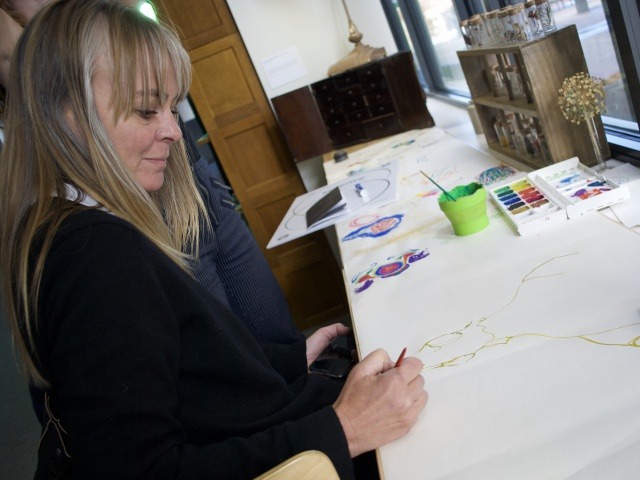
Colorado creative district leaders came to CU Boulder in October to connect with each other and campus researchers and explored NEST Studio for the Arts. (Photo by Emily Musumecci, CU Boulder)
Nov. 5, 2018 • By Sue Postema Scheeres
A recent campus conference brought together Colorado leaders who foster economic growth through the arts and CU Boulder researchers, igniting ideas for addressing communities’ social and economic issues.
The Office for Outreach and Engagement and the Colorado Creative Industries (CCI) hosted the second annual Creative District Leadership Convening on campus last month for more than 30 urban and rural leaders from Colorado’s certified creative districts and 30 CU Boulder faculty, staff and students.
Together, attendees discussed strategies for their creative district work, from community engagement, leadership and funding to evaluating the economic and social impact of their activities.
“The kind of innovative, boundary-crossing conversation that we want to foster starts with people learning about each other,” said Lisa Schwartz, co-organizer and the office’s community outreach program manager. “With this convening, we aimed to foment new relationships to see where they might go over time.”
CCI, a state government division, launched the Colorado Creative District program in 2011 to focus on creating hubs of economic activity in areas with significant concentrations of artists, cultural organizations and “creative” industries. There are currently 23 creative districts around the state, in both urban and rural areas.
“At CCI, we believe in the power of creativity to inspire human connections, create social change and support economic vibrancy throughout Colorado,” said Christy Costello, Colorado Creative District program manager and leadership convening co-organizer. “The convening was an incredible way for creative districts from near and far to connect their work with resources found within the CU Boulder community.”
Susie Kaldis, a creative district leader from Paonia, Colorado, said she was thrilled to discover the exciting projects happening on campus and make deeper connections with other creative district leaders.
“The theatre department has already reached out about a collaboration with Paonia in the spring,” Kaldis said.
The conference began with an evening panel at Fiske Planetarium where creative district and CU Boulder artists, activists and scholars discussed how the arts can contribute to creating equitable public spaces.
The main event featured “lightning talks” about community projects and campus research coupled with discussion of how to apply this work to Colorado communities. CU Boulder research included projects that offer innovative approaches to community identity and development by joining local history, art and culture with science and design. Other speakers focused on how to include families from a diversity of backgrounds and develop local economies.
Sam Schanfarber, program coordinator for the Leeds School of Business Deming Center for Entrepreneurship, described how the center’s workshops on entrepreneurship reach rural Coloradans, which resonated with creative district leaders.
“We had a blast and left with a few interesting avenues to explore for growing our program,” Schanfarber said. “We’re looking forward to participating again next year.”
Jennifer Shelby, graduate student and affiliate of the Community Engagement Design and Research Center (CEDaR), discussed her ongoing research on the challenges of evaluating the social and economic impacts of creative districts in Colorado.
A visit to the campus Nature, Environment, Science & Technology (NEST) Studio for the Arts–which combines artistic practice and scientific research–and discussion with NEST scholar Jorge Pérez-Gallego, sparked ideas about how the university can serve rural communities.
“We are sometimes forgotten in Northwest Colorado considering the challenging nature of traveling over mountain passes,” said Kim Keith, creative district leader from Steamboat Springs. “I would love to be a catalyst for more exposure to forward thinking collaborations between scientists and artists.”
Creative district leaders also participated in a separate event, CEDaR’s Community Building Colorado-Style Conference, where they talked about rapid population growth, affordability, aging infrastructure and other issues facing Colorado communities.
“It’s not every day that CU Boulder faculty, staff and students share ideas with community members from both rural and urban areas in Colorado,” Schwartz said.
Another convening is planned for Oct. 2019. Please contact Lisa Schwartz if you are interested in participating.